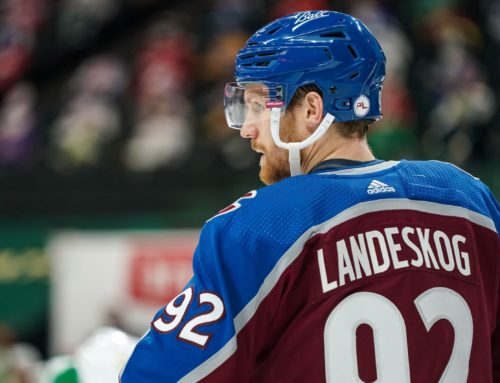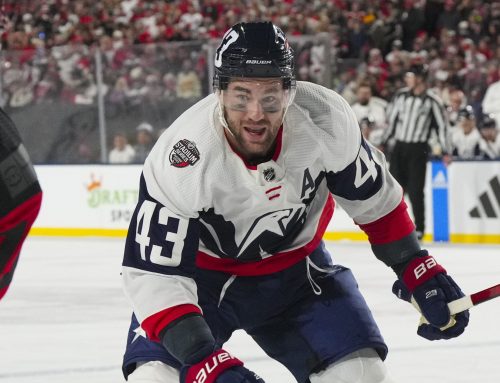Capped: Lessons Learned from the Stanley Cup Finalists
Alexander MacLean
2019-05-30

Welcome aboard for another Thursday Capped article. We’re two games into the Final now, and before we get any closer to only one team standing, I wanted to take a look into what we can learn from this year’s finalists.
There are some similarities and differences between them, but both found ways to win when it mattered most. That’s what we’re looking for in fantasy. It doesn’t have to be perfect, as there is no guaranteed recipe for success, but you need to be able to amass the points when it matters. Let’s dive in.
****
Goalies
So much has been said already this post-season about both Tuukka Rask and Jordan Binnington, that I won’t go too much in depth on what they have done. I want to focus on what their performances mean for their teams, and what they mean for us as fantasy managers.
Binnington came flying out of left field to lead the charge for the Blues and is making a statement on a league minimum contract of $650K per year. This could be lightning in a bottle or it could be the start of an excellent career, but we won’t know until later. For now, all it does is showcase how volatile goalie values can be.
On the flip side, Tuukka Rask has been spectacular as well, but is doing so in living up to his current $7 million cap hit. Boston knows what they have in Rask, and over the last five years he has been one of the most consistent goalies in the league.
On one hand, you need good goaltending to win a championship, but it is extremely difficult to predict – just ask any fantasy GM who owned Frederik Andersen in an H2H league this season. Generally, it works best to be at one extreme or the other. Own one of the top tier goalies, and ride them, or cobble together a few much cheaper starters to fill the gap. Owning second and third tier goalies is just going to weigh you down unnecessarily.
****
Skaters
Both teams have done an excellent job of assembling a core at very reasonable cap hits, which allows for the depth to fill its own role, and not be something that is cheaped-out on either. Having your star players make $5-8 million instead of $8-11 million means the lineup is longer, the depth is better, and really the star players aren’t any worse than their more highly paid counterparts.
Pulling out some names around the league, at their current salaries, would you rather own Auston Matthews, or Mark Scheifele, John Carlson or John Klingberg, Jaime Benn or Vladimir Tarasenko. You get the idea; yes you can overpay to keep your core guys, but there comes a point where they do more harm than good. Boston moved out Phil Kessel for draft picks, Tyler Seguin for depth players, and Dougie Hamilton again for picks. St. Louis meanwhile traded away Kevin Shattenkirk as a rental, then let David Backes and T.J. Oshie depart in Free-Agency when they wouldn’t fit under the cap at a reasonable number.
Backes is now a member of the Bruins, and an argument could be made that he is really the only overpaid player on either squad. That is the goal in cap leagues. One at most, and they had better at least be bringing some intangibles.
****
Team Makeup
Both teams spent close to the NHL cap, with St. Louis spending less on goaltending, but more on defence (forward cost was very similar). Neither team made a blockbuster at the deadline, though Boston did more to shore up its depth with the additions of Marcus Johansson and Charlie Coyle.
The biggest thing about filling holes with deadline deals is understanding where the shortcomings are. After the Blues addressed their need for another top tier forward in the offseason (bringing in Ryan O’Reilly), they stood pat for most of the rest of the year. They have deep roster that came together at the right time and did not show any obvious weak points. The team also had plenty of depth up front, and two starting goalies. Their only deadline deal was to get a little defensive toughness if needed as an injury replacement. Michael Del Zotto played seven games for the Blues in the regular season and has yet to be dressed in the playoffs. Lessons to be learned here: 1) Big offseason moves give you more flexibility to sort things out in-season if initially it doesn’t go as planned, and 2) Deadline deals are not always necessary.
On the Boston side, many fans and writers lamented that the Bruins gave up too much potential in Ryan Donato when trading for Coyle, however he has proved to be an excellent fit, while Donato is still just finding his way in the NHL. Johansson has also fit in seamlessly, and the two forwards have given something the Bruins were missing (as much as the team with the second-best regular season record can be missing anything), which was depth scoring. Knowing where your team is weak requires looking at your squad with an impartial eye (or bringing things to the masses on the forums), sorting out whether you need assists, hits, or another goalie. The bottom line here is that you can never have too many riches, but sometimes it’s the smaller pieces in the right spots that can bring more than just their solitary value to a team.
****
Franchise Trajectory
Both teams have had success in reaching the playoffs in the salary cap era. Neither has had their own pick inside the top-10 selections in the last 10 drafts (Boston had two from Toronto in the top 10 from the Phil Kessel trade).
For those of you rebuilding, these are the teams to be looking at showing you that you don’t have to. St. Louis missed the playoffs last year on the last game of the season and was in last halfway through this year. They made adjustments, they won games, and they are now so close to the Cup they can almost taste it. In fantasy things are no different. Some rosters require a little more love than others, but there is no reason a rebuild should have to take as long as it is for the Edmonton Oilers.
The rosters have been turned over with three main focuses: Keeping a core under control with manageable contracts, occasionally making a trade to get younger, and managing the farm system so that there are always pieces to mix between trade assets and internal growth. Not for many years now have either of these teams been without a handful of core players in their prime years – those are the blocks to build around, and make moves to shore up so that they can have a chance to succeed year-in and year-out.
Let the rebuilders in your fantasy leagues lose and collect prospects if that’s what they enjoy, but in fantasy there’s always room at the top for those that put in the time to get there.
****
What teams then best fit the model above for next year? Between a solid core of three defencemen and four forwards paid at a reasonable rate, good drafting, and solid depth/minor league systems, that would probably be the Calgary Flames and the Florida Panthers. That would be quite something… I wonder what the odds are at today of that happening next spring?
****
Previous Capped articles:
On the Comeback Trail from-Injury Plagued 2018-19
Assessing the Goaltending Market
****
That caps off this week’s article, thanks for reading. As always, you can find me on twitter @alexdmaclean.





 T.B
T.B FLA
FLA NYI
NYI CAR
CAR TOR
TOR VGK
VGK VAN
VAN EDM
EDM MIN
MIN STL
STL
